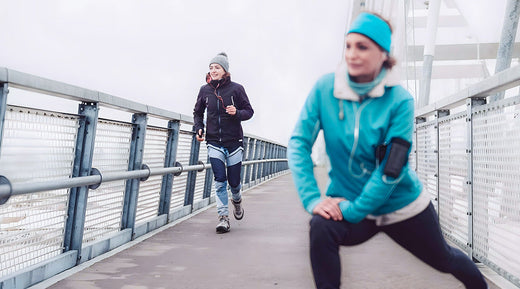
10 Tips To Stay Healthy Throughout The Cold Weather Months
A nice thirty-minute walk or run outdoors is not only good for your heart and lungs, but also for the soul!
Ah, fresh air, sunshine, and movement, there’s nothing like it.
But what do you do when it’s pouring rain, or barely 10 degrees above 0, or there’s a foot of snow on the ground, or a layer of ice covering everything in sight?
The cold weather months can brutally affect our efforts when it comes to physical activity, and when our exercise efforts are diminished, this can actually create a ripple effect, negatively impacting many healthy habits.
While physical activity isn’t the only component of a healthy lifestyle, studies confirm that regular exercise leads to positive changes in diet, sleep, stress management, and more.
In other words, exercise is a vitally important part of whole-body health and wellness.
And, when you’re limited on indoor space and the outdoor temps and weather aren’t exactly cooperating with your healthy endeavors, sometimes you have to get creative to stay motivated and keep moving.
So, let's take some time today to look at a few cold weather solutions, exploring a variety of ways to stay healthy throughout the winter months, even when you don’t have a gym membership, even when you’re forced to work out indoors, even when you’re limited on space…even, even, even…
That’s right, we’re tackling all the winter workout obstacles in one place today, so without further ado, let’s jump right in!
10 Tips To Stay Healthy Throughout The Cold Weather Months

Throughout the winter months, the cold, snow, and rain can really put a damper on your efforts, even zapping your motivation altogether.
Certainly, less than ideal outdoor weather seems to affect exercise the most, but the cold can hinder other aspects of health and wellness too:
- When it’s cold and dreary, perhaps you have a hard time leaving the comfort of your warm bed.
- When the temps are frigid, even though it’s warm and toasty indoors, sometimes hydration becomes more difficult.
- During the colder months, comfort foods (those which don’t always align with your health goals) can be more tempting.
- When you’ve not seen the sunshine “in three dang days,” it can do a number on your mental health.
- And, when you’re limited on space, sometimes working out indoors seems nearly impossible.
All of these can wreck intentions and throw a wrench in your efforts to stay healthy, so let’s explore some solutions to these common cold weather problems.
First, since exercise is often the most affected by these conditions, we’ll explore several tips to keep you moving.
Then, we’ll briefly look at a few tips addressing other areas pertinent to optimal health, looking at ways to combat any wintertime obstacles here as well.
1- Body Weight Exercises

There are a number of whole-body movements you can do indoors, even with limited space, to get a tremendously effective workout.
When it comes to cardio, consider the following movements (the number of sets and reps depends on your current ability and goals):
- Jumping jacks
- High knees
- Running in place
- Step ups
- Mountain climbers
- Burpees
- Jump squats
- Running lunges
And, for strength training there’s also a number of highly effective exercises you can do which require nothing more than your body weight:
- Push-ups (multiple varieties)
- Crunches or sit ups (multiple varieties)
- Squats
- Lunges
- Planks
- Tricep dips
- Arm circles and arm raises (front and lateral)
- Wall sits
- Calf raises
Then of course, yoga, pilates, and stretching exercises can incorporate both cardio and strength training using nothing more than your body weight as well.
- Vinyasas
- Downward dog
- Warrior poses
- Bridge pose
- Side plank pose
Some of the above listed options may look familiar while others may be foreign to some.
So, if you’re looking for a place to start, check out the following links which provide detailed descriptions for some of the exercises we’ve mentioned above (and many more).
Cardio - https://www.nike.com/gb/a/cardio-workout-at-home
Strength Training - https://www.everydayhealth.com/fitness/the-best-bodyweight-exercises-for-working-out-every-part-of-your-body/
Yoga - https://www.yogajournal.com/practice/bodyweight-strength-exercises/
General - https://www.medicalnewstoday.com/articles/cardio-exercises-at-home#
2- Free Weights

A simple set of free weights consisting of 5, 10, 15, and 20 pound weights can really help you accomplish a lot, without taking up much space.
Personally, right now I do have a gym membership, but any time I need to work out from home, I simply retreat to my teeny, tiny laundry room to get in a great workout.
Any and all of the following exercises using free weights are more than possible in my laundry room, which provides little more than enough room for a yoga mat, so if you’ve got that much space, I can assure you these movements are completely doable!
- Bicep curls
- Tricep extensions
- Shoulder press
- Lateral raises
- Hammer curls
- Military press
- Floor chest press
- Deadlifts
- Bent over rows
- Weighted calf raises
- Weighted squats
The above exercises should be enough to get you started, but if you need a few visuals, check out the following links for some tutorials covering many of the exercises listed above (and more).
https://www.onepeloton.com/blog/beginner-dumbbell-workout/
https://www.tomsguide.com/news/forget-the-gym-this-6-move-dumbbell-workout-can-be-done-from-home-with-limited-space
https://www.healthline.com/health/dumbbell-exercises-for-arms#bottom-line
https://www.healthline.com/health/fitness-exercise/free-weight-exercises#intermediate-routine.
3- Videos/Online Tutorials

We’ve already listed a few links you can check out for some how-tos and a few extra ideas when it comes to doing both body weight and free weight exercises, both of which are optimal for indoor workouts with limited space.
But, there’s also a wealth of information online.
When working out from home, there are plenty of options to choose from when subscribing to programs which provide you with workouts, meal plans, etc. such as BeachBody, Syatt Fitness (Inner Circle), etc.
But, you can also find tons of free resources, including full length training videos, online.
When looking for workout videos, I would suggest hopping on over to YouTube and searching for specifics, though even a general internet search for content such as “whole body at-home workouts,” “free weight arm workouts,” “basic leg day workouts,” can be helpful.
Once you’ve found some videos suitable to your style, set up, and goals, just remember, if one video or trainer isn’t to your liking or preference, keep searching as there are a mountain of options to choose from.
Here’s a few quick videos to get you started:
General - https://www.youtube.com/watch?v=h5qPSqJJCCk
Full Body - https://www.youtube.com/watch?v=ccsPUcdgJzM
Low Impact - https://www.youtube.com/watch?v=jKTxe236-4U
Walking Workout For Seniors - https://www.youtube.com/watch?v=LYJ3U0Fs4dg
4- Little Equipment, Big Gains

Aside from free weights, there are other items you can purchase that take up very little space but serve to enhance your indoor workout experience. While there are a wide variety of items we could list here, to save time, we’ll stick to 8…
Adjustable Dumbbells - A set of adjustable dumbbells can be considered an investment due to the price point on some of these items, but they offer a wide range of weights to use while taking up minimal space.
Walking Pad - Okay, this one’s on my wish list! Walking pads are essentially treadmills minus the arm support and any other bells and whistles.
Many folks choose to use walking pads at their desk so they can stand up and work while walking. Walking pads are even great to slide under your bed or couch, then pull it out and get in a workout while you watch your favorite Netflix series in the evening.
Kettlebells - Kettlebells work in a similar way to free weights, offering weighted options for a variety of movements (often different from general free weight exercises).
Wrist & Ankle Weights - Wrist and ankle weights can be worn during a workout or throughout the day as you tackle your indoor chores, allowing you to work out while you crush your to-do list.
Yoga Mat & Block - Using a yoga mat and yoga block can help with multiple movements and workouts, even providing a space for some traditional full body exercises as well.
Jump rope - If you’re in a very, very tight space, a jump rope might not be your best bet, but with a little extra room, you can get in a super sweat session with a jump rope.
Resistance Bands - If you need an option that’s just as effective as free weights without taking up as much space, or weight, then resistance bands are the way to go.
Instead of using weight, resistance bands work by oppositional force. Basically, the elastic bands create tension, and your muscles are strengthened by working against this tension to stretch the band.
Suspension Trainer - Suspension training has become popular in recent years as this type of system generally takes up very little space and allows you to get an incredibly effective whole-body workout as long as you have a place to anchor the suspension equipment.
Once anchored, you can use TRX straps (total resistance exercises) to do a variety of exercises from the comfort of your own home.
5- Hydration

Thus far, we’ve focused primarily on indoor exercises you can incorporate, even in small spaces, throughout the cold weather months. But, physical activity is only one part of a healthy lifestyle.
Hydration also plays a vital role in health and wellness, and when you’re regularly exercising, you’ll likely need to up your liquid intake to replenish what your body loses through sweat.
The average recommended amount of water intake per day is 15.5 cups for men and 11.5 cups for women.
But, if you’re struggling to hit these marks due to the cooler winter temps, consider supplementing your water intake with warm beverages such as coffee, tea, bone broth, and even consider sipping on warm lemon water if ice cold H2O becomes problematic.
Personally, I can only do so much cold, or even lukewarm, water in the winter before I seemingly “freeze to death.”
Yes, that’s a tad dramatic, but I combat these winter water intake woes by sipping on warm lemon water, often with a scoop of collagen added to the mix to amplify the health benefits and increase my protein intake.
6- Nutrition

The terms ‘diet and exercise’ are regularly used when speaking of health. Why? Because the two go hand and hand.
Some would definitely argue that nutrition is more valuable than physical exercise, but when it comes right down to it, both bring unique benefits, and both are vital for optimal health.
I would even add that one amplifies the other, as working out often prompts us to make better nutritional choices, and likewise, prioritizing nutrition often encourages consistent exercise.
While varying dietary needs and fitness goals can necessitate different options when it comes to nutrition, generally speaking, whole food choices will always best support your body.
With this in mind, consider options such as:
- Fresh fruits and vegetables
- Whole grains
- Real food proteins such as lean meats, fish, poultry, and eggs
- Healthy fats such as avocado oil, coconut oil, olive oil, tallow, ghee
- Nuts, legumes, lentils, and beans
- Depending on dietary needs: whole or low-fat dairy, greek yogurt, etc.
7- Sleep Quality

Good, quality sleep is vital for whole body health and wellness, especially during the cold winter months, as our bodies signal for needed rest.
As the days are shorter (less sunlight) and the temperatures are colder, some experts have concluded that humans need more sleep, specifically more deep sleep in such conditions.
Generally speaking, 7-9 hours of quality sleep is recommended for adults.
During the winter months, however, try turning in a bit earlier if you can, maybe forgoing that extra episode on tv or those extra pages in that “can’t put it down” fictional story.
Even if you can’t spare an extra 30-60 minutes for added sleep time, try to incorporate the following tips to ensure you’re getting good, quality sleep each night:
- Establish a bedtime routine
- Avoid caffeine and alcohol close to bedtime
- Turn off electronics within 1-2 hours of sleep
- Switch to warm lighting near bedtime (think candlelight, skip the LED, avoid blue light)
- Limit naps during the day
- Consider sipping on warm chamomile tea an hour or so before bedtime
- Seek to keep your bedroom dark and cool (between 65-68 degrees Fahrenheit)
- Incorporate daily exercise
- Prioritize a healthy, nutritious, diet
8- Stress Management

Especially during the winter months when your intake of sunlight decreases and your fresh air exposure is limited, stress management is key.
Basically, being confined to the indoors can take its toll on some people…it’s me, I’m some people.
And, if you’re like me - or like most people, per science - stress management becomes a greater need during the winter months when most of us lack the ability to go for long walks out in the fresh, wide open, great outdoors.
Then, we began our discussion by focusing on indoor workouts due to the cold temps and winter weather limiting our time outdoors, but getting in that physical activity can also put stress on our bodies.
Now, don’t get me wrong, this kind of stress is a good thing, but it also highlights the body’s general/overall need for stress management.
So, especially during the winter months, seek to effectively manage stress for optimal health by incorporating any of the following:
- Journaling
- Self-care practices like massages, long warm baths, etc.
- Listening to music
- Reading your favorite book
- Meditation
- Deep breathing
- Mindfulness
- Aromatherapy
- Quiet morning coffee time
9- Rest

We already mentioned sleep, but here I briefly wanted to mention rest from exercise.
As you move your workouts indoors for the winter, sometimes these exercise sessions can be more intense than your usual stroll around the neighborhood in warmer weather.
So, if you’re pushing your body hard several days a week, be sure to give yourself at least one day of rest.
You can even plan to do an active rest day, if desired, one dedicated to slower movement, stretching, and recovery.
10- Routines

Something I’ve personally found to be true, and the experts back this up, is that a routine is absolutely priceless when it comes to prioritizing health and wellness.
Whether you’re retreating to your teeny tiny laundry room in the wee morning hours to get in a workout, drinking water like clockwork throughout the day to achieve your hydration goals, or hitting the hay at 9:30 on the dot and waking precisely at 6:00 each morning, these routines are vital when it comes to motivation, consistency, and your general wellbeing.
Routines not only help to reduce stress, they also essentially put your body on autopilot when it comes to incorporating all the healthy practices we’ve detailed here today.
Routines are proven to help you create and maintain healthy habits all throughout the year, even during those cold winter months - when you feel like staying warm beneath your bed covers instead of working out and when you feel like binging Netflix at night and drinking hot cocoa instead of high-quality H2O.
So, map it out or start by incorporating a few small healthy habits. Then, make it a routine, building upon those healthy choices, and before you know it, your healthy routines will be second nature, allowing you to reap all the rewards of those consistent healthy habits!
Check out Lifeboost Coffee Grata Medium Roast.
Medical Disclaimer
This content is for informational and educational purposes only. It is not intended to provide medical advice or to take the place of such advice or treatment from a personal physician. All readers/viewers of this content are advised to consult their doctors or qualified health professionals regarding specific health questions. Neither Dr. Charles Livingston nor the publisher of this content takes responsibility for possible health consequences of any person or persons reading or following the information in this educational content. All viewers of this content, especially those taking prescription or over-the-counter medications, should consult their physicians before beginning any nutrition, supplement or lifestyle program.

Becky is a mother, educator, and content writer for Lifeboost Coffee. She has had three years’ experience as a writer, and in that time she has enjoyed creatively composing articles and ebooks covering the topics of coffee, health and fitness, education, recipes, and relationships.
- https://www.heart.org/en/healthy-living/fitness/fitness-basics/why-is-physical-activity-so-important-for-health-and-wellbeing#
- https://www.healthline.com/health/fitness-exercise/arm-exercises-no-weights#muscles-worked
- https://wellhub.com/en-us/blog/fitness/cardio-exercises-you-can-do-at-home/
- https://health.clevelandclinic.org/should-you-try-resistance-bands-for-strength-training
- https://www.livestrong.com/article/13724083-how-use-trx-straps/
- https://www.health.harvard.edu/staying-healthy/how-much-water-should-you-drink
- https://www.piedmont.org/living-real-change/diet-vs-exercise-for-weight-loss#
- https://www.nhs.uk/live-well/eat-well/how-to-eat-a-balanced-diet/eating-a-balanced-diet/#
- https://www.healthline.com/health-news/seasonal-sleeping-why-we-need-more-rest-in-the-winter#
- https://www.mayoclinic.org/healthy-lifestyle/adult-health/in-depth/sleep/art-20048379#
- https://www.sleepfoundation.org/bedroom-environment/best-temperature-for-sleep#
- https://www.mayoclinichealthsystem.org/hometown-health/speaking-of-health/seasonal-affective-disorder-not-just-the-winter-blues#
- https://www.nhs.uk/mental-health/self-help/guides-tools-and-activities/tips-to-reduce-stress/
- https://newsinhealth.nih.gov/2018/03/creating-healthy-habits
- References for the article to confirm data and information.
Drop a Comment
I won’t EVER DRINK ANY Other coffee than
Lifeboost ground coffee!!!!! I order 2or3bags @ (when on sale) & NEVER RUN OUT!!!!!!! It starts my day!!!!!!!Each order I make at the
time I freeze (any other than the first bag(that I always keep in my refridge and
take out to scoop each morning!!!!! They freeze beautifully & the one I use daily stays
So very fresh !! Try ordering more tan one bag! You will love it!!!!
Ever so fresh!!!!!










